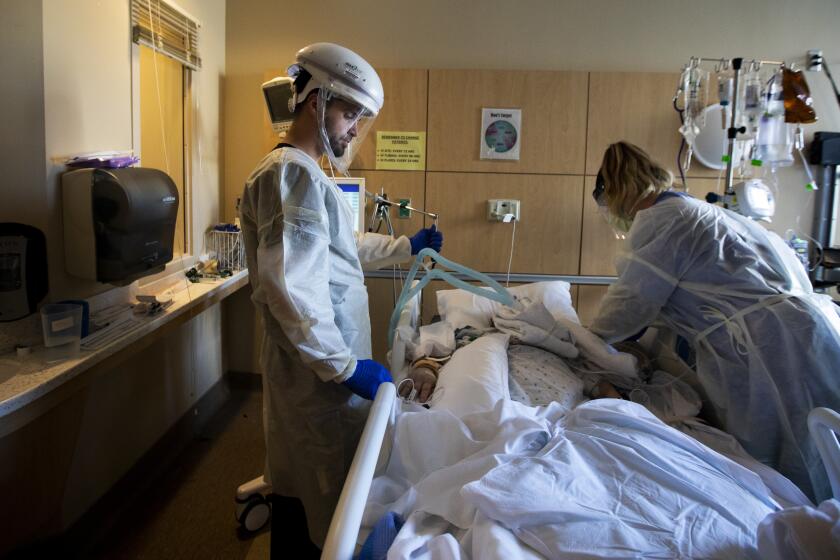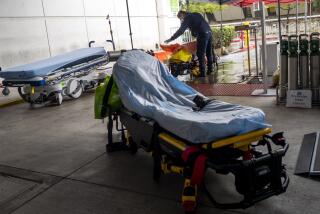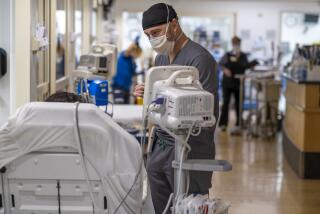Surge in military coronavirus cases puts pressure on San Diego Navy hospitals
- Share via
SAN DIEGO — Like their civilian counterparts, San Diego’s two major military hospitals are taking in a wave of coronavirus patients as the winter surge in cases affects military members, their families and retirees.
At Naval Medical Center San Diego, its 16 intensive care unit beds are at 70% capacity, and Naval Hospital Camp Pendleton’s four ICU beds are at 75%.
“While our team is busy, the ICUs are not full,” said Regena Kowitz, a spokeswoman for Navy Medical Forces Pacific. Kowitz said both sites have plans to increase patient capacity if necessary.
Frontline military healthcare providers at both hospitals told the San Diego Union-Tribune on Friday that coronavirus cases in the communities they serve, just like in the greater San Diego area, have surged in recent weeks.
“The majority of people say they believe they got it from someone close to them, like their significant other,” said Ensign Samantha Salus, a nurse in the COVID-19 ward at Naval Medical Center San Diego, during an interview Friday. “Just like our civilian counterparts, we’re seeing an influx of patients.”
After hitting L.A., COVID-19 wave now battering Southern California’s suburban counties: Orange, San Bernardino, Riverside, San Diego and Ventura.
Hospital Corpsman 2nd Class Christopher Pruitt is a supervisor for the COVID-19 and Flu Clinic at Naval Hospital Camp Pendleton, which he explained was some tents set up near the emergency room to screen patients and test for the coronavirus.
Pruitt said he also has seen a “large increase” in coronavirus patients in the last several weeks, which has led to medical staff in the clinic working longer hours and extra days.
“As a hospital, we had to create a new department — a new clinic,” he said, adding that his patients reported being exposed at work or where they’ve recently traveled.
How widespread is the coronavirus among the military community in San Diego? It’s difficult to say with certainty.
The Pentagon releases total numbers of virus cases in the military by the military branch, but it does not disclose any geographic data. The Navy provides weekly updates, so it’s possible to track the total number of Navy cases worldwide.
So far more than 6,000 sailors have tested positive for the virus since the beginning of November, according to the Navy’s published numbers. The Navy reported 2,980 active cases as of Wednesday, with eight sailors hospitalized.
One in six active-duty Navy sailors is based in San Diego County, according to a 2019 study. Applying that ratio to the service’s total active cases suggests about 500 San Diego sailors could be positive for the virus.
Kowitz declined to comment on the number of COVID-19 cases.
Leaders in the Navy medical community lauded frontline healthcare workers in statements Friday.
“Our frontline medical personnel have put forth a tremendous effort to meet the mission during these unprecedented times and it has certainly placed a strain on them but they are resilient and their commands and the region are ensuring they are getting the support they need,” said Rear Adm. Tim Weber, the commander of Naval Medical Forces Pacific.
Capt. Shelly Perkins, the director of Naval Hospital Camp Pendleton, acknowledged the difficulties the staff has encountered throughout the pandemic.
“This has been a difficult year for everyone, across the military and our nation, and the exceptional staff here at Naval Hospital Camp Pendleton has risen to the challenge,” Perkins said in a statement. “The military has taught us to stay ready and be sharp so that we can adapt to changing situations.”
Capt. Bradford Smith, the commanding officer of Naval Medical Center San Diego, said the work of the hospital staff has helped the fleet stay operational amid the pandemic.
Both hospitals will be among the first in the military to receive doses of Pfizer’s new COVID-19 vaccine, the Defense Department announced Wednesday. The first doses could arrive as early as this week, according to Alex Azar, the Health and Human Services secretary.
The latest maps and charts on the spread of COVID-19 in California.
In the military — as in the civilian world — the first in line to receive vaccines will be healthcare providers, support personnel and residents of long-term care facilities, said Thomas McCaffery, the assistant secretary of defense, at a Wednesday news conference.
Service members engaged in essential national security and installation functions or deploying forces and military beneficiaries at high risk of developing severe illness from COVID-19 also will receive vaccines before other members of the services, according to a Pentagon news release.
However, because delays in administering the vaccine among the general population are expected, both Salus and Pruitt said people in the community should continue to do what they can to limit the spread of the virus.
“I’d encourage people to continue wearing masks and social distancing,” Salus said. “Not just in the military setting but in the community, to help the hospitals.”
Dyer writes for the San Diego Union-Tribune.
More to Read
Sign up for Essential California
The most important California stories and recommendations in your inbox every morning.
You may occasionally receive promotional content from the Los Angeles Times.













